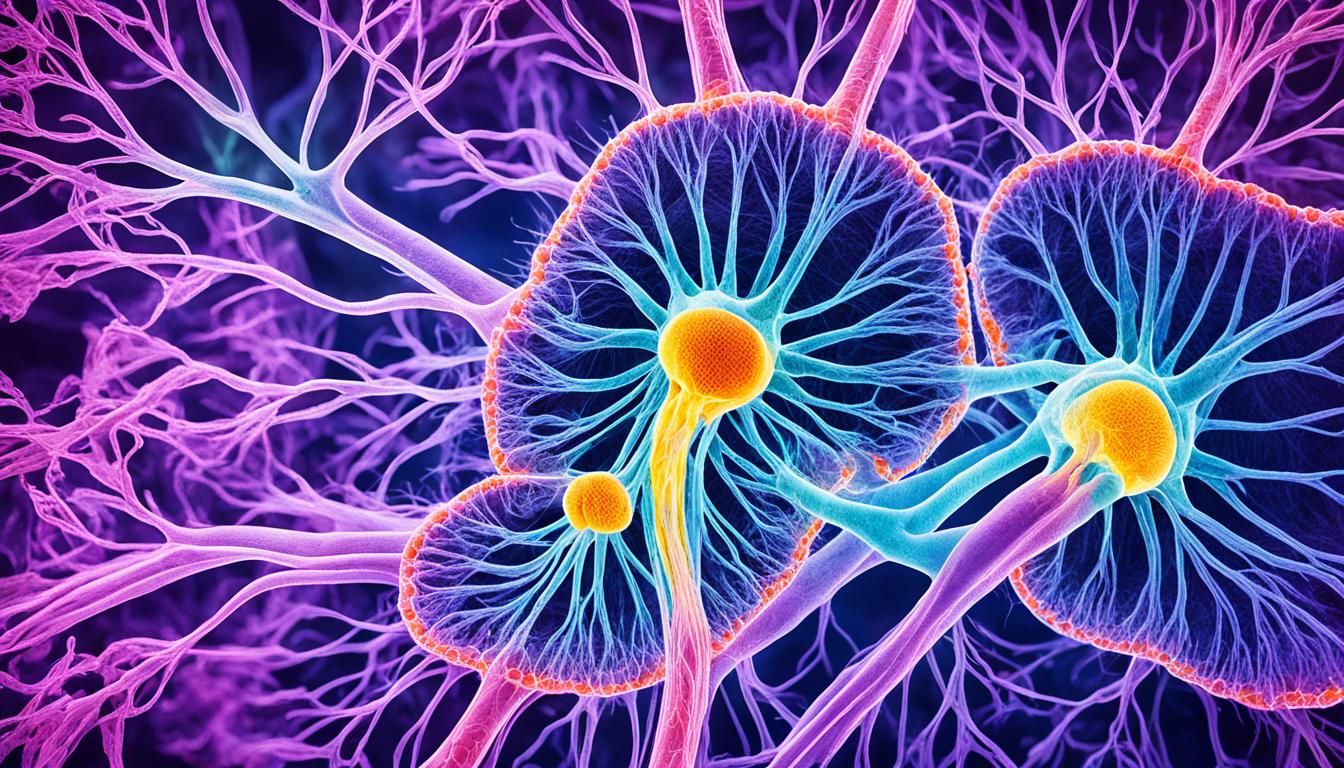A pinched nerve can lead to many problems in the body. Symptoms like numbness, tingling, and sharp pain are common. Causes include herniated discs, carpal tunnel, and bone spurs.
Orthopedic surgeons can diagnose and treat these issues. Sometimes, surgery is needed. But, stem cell therapy offers another path. It can reduce pain and help you move better.
Key Takeaways:
- A pinched nerve may cause numbness, tingling, and muscle weakness.
- It’s often due to herniated discs, carpal tunnel, or bone spurs.
- Surgery can be an option, but stem cell therapy is an alternative.
- Stem cell therapy uses stem cells to repair nerves and tissues.
Don’t let a pinched nerve stop you. By understanding the issue and what help is available, you can get your life back. Learn about the symptoms and treatments. This knowledge can be your key to relief and better living.
Stem Cell Therapy for Pinched Nerves: A Revolutionary Treatment Option
In recent years, stem cell therapy has become a leading treatment for pinched nerves. It uses the power of stem cells to repair nerves and tissues. Unlike traditional methods, this approach is non-invasive.
Stem cells can come from the patient’s own body or from donors. They can turn into different types of tissue, like nerves. By injecting these cells into the damaged area, they stimulate repair. This gets to the root of neuropathic pain.
Compared to surgery, stem cell therapy is less invasive and has fewer side effects. After the procedure, most patients can go back to their daily lives right away. It can also be used with other treatments like physical therapy.
Healing Damaged Tissues with Stem Cell Therapy
Stem cell therapy can help heal tissues damaged by pinched nerves. These nerves are often compressed by things like herniated discs or bone spurs. This therapy targets the main problem, helping to fix the tissues and reduce pain.
Stem cells release substances that aid in healing. This includes growth factors and anti-inflammatory molecules. They also help calm down the body’s response to the nerve damage.
Addressing Neuropathic Pain with Innovative Treatments
Neuropathic pain from pinched nerves can be very hard to deal with. Common treatments often just cover up the pain temporarily. Stem cell therapy is different. It aims to heal the nerves for long-lasting pain relief.
This approach doesn’t just mask the pain. It works to fix the issue causing the pain. By regenerating tissues and repairing the nerves, it helps improve function and reduce pain for the long term.
An Exciting Future for Regenerative Medicine
Stem cell therapy is at the forefront of regenerative medicine. Continuous research is finding new ways to make this treatment even better. We’re exploring how it can help with more conditions.
This therapy is a big step forward in medicine. By using our own cells to heal, we’re opening doors to better, more life-changing treatments. Stem cell therapy offers hope for a future with improved health and well-being.
Stem Cell Therapy for Sciatic Nerve Injury: A Game-Changer in Treatment
Sciatic nerve injury brings severe pain from the lower back, through the buttocks, down to the legs. Past treatments included surgery or steroid shots, but these had risks and often didn’t offer lasting relief. Fortunately, a new approach, stem cell therapy, is now changing the game without the need for surgery.
Stem cell therapy uses mesenchymal stem cells. These come from the patient’s own fat or bone marrow, or they can be donated from sources such as cord tissue or placenta. These cells are amazing because they can rebuild damaged nerves.
This method shows great potential in fixing nerve damage and easing the pain. The treatment is customized for each patient and includes several steps. While the process is done without surgery, it’s important to have regular medical visits for monitoring. Patients might need to stay in Bangkok briefly for complete care.
FAQ
Q: What are the common symptoms of a pinched nerve?
A: A pinched nerve often causes numbness, tingling, and sharp pain. People might feel muscle weakness and a sensation like pins-and-needles.
Q: What can cause a pinched nerve?
A: Herniated discs, carpal tunnel syndrome, and bone spurs are common causes. These issues can put pressure on nerves, leading to a pinched nerve.
Q: How are pinched nerves diagnosed and treated?
A: Orthopedic surgeons diagnose and treat pinched nerves. Sometimes surgery is needed. But, there are other treatments like stem cell therapy. This option can reduce pain and improve movement without surgery.
Q: What is stem cell therapy?
A: Stem cell therapy is an advanced treatment. It uses the patient’s own stem cells or donated ones to repair nerves and tissues. This method is not invasive and has no recovery time.
Q: Can stem cell therapy help with pinched nerves?
A: Stem cell therapy has helped many people with pinched nerves. It can reduce nerve pain and help the body heal the nerves.
Q: How does stem cell therapy work for sciatic nerve injuries?
A: For sciatic nerve injuries, using mesenchymal stem cells has been a big breakthrough. It can repair nerve damage and ease pain.
Q: Where are stem cells sourced from for therapy?
A: Stem cells come from the patient’s body, like from fat or bone marrow. They can also come from donated sources, like cord tissue. Or they might come from the placenta.
Q: Are traditional treatments effective for sciatic nerve injuries?
A: Often, regular treatments like surgery or steroid shots don’t give lasting relief for sciatic nerve injuries.
Q: Is stem cell therapy a non-surgical treatment option for sciatic nerve injuries?
A: Yes, stem cell therapy doesn’t need surgery. It’s an option for treating sciatic nerve injuries without an operation.
Q: What does the treatment plan for sciatic nerve injuries typically involve?
A: The plan usually has several steps, made for each person’s needs. It might include a stay in Bangkok for the best care.

